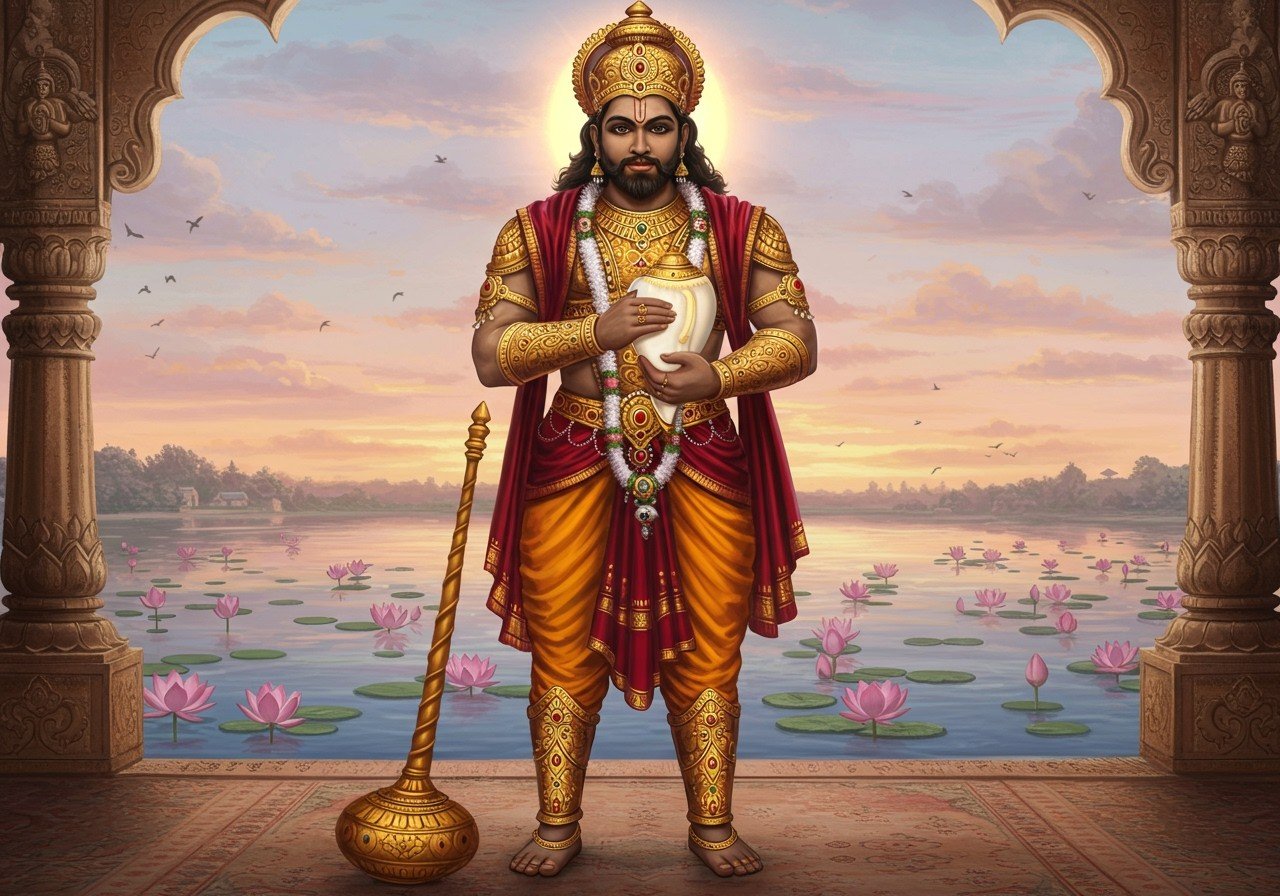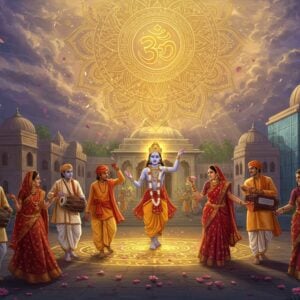
Embarking on a spiritual journey through the Mahabharata reveals the profound significance of conch shells in Indian tradition. These sacred instruments, far beyond mere ceremonial tools, carry deep symbolic meaning and spiritual weight. In this epic narrative, each Pandava brother possesses a unique conch, a symbol of their individual power and divine connection. Let’s explore Sahadeva’s role, the youngest Pandava, and his conch, to understand the beautiful intertwining of tradition and the reverence for symbolic artifacts.
The Resonance of Conch Shells in the Mahabharata
In ancient Indian scriptures like the Mahabharata, conch shells resonate with historical and spiritual significance. They embody divine power and victory, serving as powerful instruments to herald the start of battles. Each Pandava brother wields a unique conch, imbued with its own name and potent energy. Prominent in religious ceremonies, conch shells represent purity and auspicious beginnings. The resounding sound of a conch is believed to dispel negative energies and invite positivity, deeply impacting the warriors’ morale on the battlefield. You can find authentic conch shells and other pooja samagri at Poojn.in.
Sahadeva, the youngest Pandava, stands out for his wisdom and strategic thinking, serving as a trusted counselor to his brothers. His skills in astrology and unwavering loyalty highlight his significant role in the epic. Sahadeva’s intellect and foresight proved invaluable to the Pandavas’ success. Within the grand narrative of the Mahabharata, his inner strength beautifully complements his strategic mind.
Sahadeva’s conch, known as Manipushpaka, embodies wisdom and foresight, reflecting his unique character traits. Its symbolism resonates with his strategic acumen. The distinct sound of Manipushpaka is believed to have a profound effect on the battlefield. The rituals associated with blowing the conch hold deep spiritual meaning, enhancing Sahadeva’s dual role as both a warrior and a sage. This conch continues to hold cultural relevance in contemporary Indian ceremonies.
In Hindu rituals, conch shells hold a vital place, particularly in temple ceremonies. The resonant sound of the conch during meditation and prayer carries profound spiritual connotations. Even in today’s world, the symbolism of the conch from the Mahabharata continues to influence various practices. The conch represents the cosmic sound ‘Om’ and invites prosperity into homes. It maintains its significance in yoga and other spiritual practices, playing a key role in festivals and the preservation of our rich cultural heritage.
Sahadeva and His Conch: Manipushpaka – A Symbol of Wisdom
In the epic Mahabharata, Sahadeva’s conch, Manipushpaka, occupies a place of honor. The name itself, “Manipushpaka,” translates to “Jewel Bracelet,” reflecting its precious nature. Sahadeva, the youngest Pandava, distinguishes himself with his wisdom and sharp strategic mind. His conch symbolizes intelligence and cunning in warfare. Blown with purpose, the sound of Manipushpaka marked the commencement of the Kurukshetra War, serving as a powerful war trumpet.
The sound of Manipushpaka, subtle yet captivating, mirrors Sahadeva’s strategic thinking. His ability to outmaneuver opponents with skill and intellect is legendary. The conch signifies his role not only as a warrior but also as a deep thinker, always planning and advising his brothers. It’s a testament to his foresight and strategic prowess.
The Significance of Conch Shells in the Mahabharata: A Symbol of Power
Conch shells in the Mahabharata transcend their function as mere battle instruments. They are potent symbols of power, resounding victory, and auspicious new beginnings. Both the Pandavas and Kauravas used them as war trumpets, their loud, resonant sound known as “ghosha.” Each prominent warrior in the Mahabharata possessed a unique conch, each with its own name and rich significance. You can explore a variety of conch shells available at Poojn.in.
The conch shell is deeply associated with positive energy. Blowing a conch is believed to enhance courage, determination, and hope, while dispelling negative energy and warding off evil spirits. This belief underscores the spiritual significance of conches in ceremonies and sacred rituals.
Furthermore, the conch shell holds a sacred connection to Lord Vishnu, who is often depicted holding it. This association further elevates its divine symbolism and reverence in Hindu traditions. Discover beautiful Lord Vishnu idols at Poojn.in to enhance your spiritual practice.
Cultural and Spiritual Interpretations: The Enduring Legacy
Conch shells play an integral role in Hindu rituals, holding a place of honor in temple ceremonies. Their sound signifies purity and invokes divine blessings. The conch’s resonance is likened to the cosmic ‘Om,’ vibrating with spiritual energy. In Indian homes, the conch symbolizes prosperity and good fortune, holding a special place in modern spiritual practices like yoga and meditation. The sound of the conch is believed to harmonize energies, making it a powerful tool for spiritual growth.
The influence of the Mahabharata extends far beyond ancient texts, shaping contemporary culture. Festivals often feature the blowing of conches, a beautiful way to preserve our rich cultural heritage. This enduring symbolism connects us to our roots, reflecting timeless wisdom.
Poojn.in: Connecting You with Sahadeva’s Conch Symbolism
Sahadeva’s conch stands as a symbol of wisdom and purity in the Mahabharata. At Poojn.in, we offer products that connect you with this powerful spiritual symbolism. Our 100% Original Vamavarti Shankh is a sacred emblem resonating with the essence of life. This non-blowing conch shell holds immense significance in Hindu culture, believed to dispel negative energies and purify your surroundings. Explore our Vamavarti Shankh here.
- Material: Crafted from the finest snail material, it showcases a natural white color, symbolizing purity and spiritual cleansing.
- Uses: Ideal for pooja or as a sacred decoration, it serves as a beacon of tranquility and invites positive energy into your space.
- Weight & Size: Weighs between 100 – 1000 gm and measures 5 – 8 inches in length, making it a perfect addition to your altar or home.
The Vamavarti Shankh is revered as the brother of Goddess Lakshmi and a favorite of Lord Vishnu, symbolizing their divine connection. It is an ideal choice for those seeking spiritual harmony and enlightenment. You can also find other culturally significant items at Poojn.in.
For more information or to purchase, contact us at 03369029784 or WhatsApp at 9476142738. Embrace the profound symbolism of Sahadeva’s conch with our authentic offerings at Poojn.in.
Conclusion: The Eternal Echo of Manipushpaka
Sahadeva’s conch, Manipushpaka, transcends its role as a mere instrument of war. It embodies wisdom, strategic brilliance, and spiritual depth. As the youngest Pandava, Sahadeva uses Manipushpaka not only to signal the start of battles but also to represent the power of intellect and foresight.
The conch shell, with its sacred sound, creates a bridge between the earthly and the divine. It carries the echoes of courage and wisdom from the Mahabharata into our lives today. By understanding its profound significance, we connect with ancient wisdom, bringing its timeless teachings into our homes and hearts.
As you embrace the resonant sound of the conch, let it serve as a reminder of the strength we find in strategic thinking and the peace we discover through spirituality. Whether used in rituals or personal reflection, the conch’s call is a timeless invitation to honor tradition and embark on a journey of inner growth.
Understanding Sahadeva’s Conch: FAQs
What was Sahadeva’s conch called?
Sahadeva’s conch was known as Manipushpaka, a name that translates to “Jewel Bracelet.” This name reflects the precious nature and symbolic importance of the conch.
Why are conches significant in the Mahabharata?
In the grand narrative of the Mahabharata, conches represent power, authority, and the righteousness of the warriors. They are blown to announce the commencement of battles and to uplift the morale of the armies.
What does Manipushpaka symbolize?
Manipushpaka, Sahadeva’s conch, embodies his wisdom and strategic mind. It represents his ability to think clearly even in the midst of chaos and to offer wise counsel to his brothers.
How did Sahadeva use his conch in the epic?
Sahadeva blew Manipushpaka on the battlefield to signal his presence and his readiness to fight. The sound of his conch served as a declaration of his courage and his commitment to dharma.
Are there any rituals associated with conches like Manipushpaka in Indian culture?
Yes, conches play an essential role in Hindu rituals and ceremonies. They are blown to purify the environment and invite positive energy into sacred spaces, much like the role they played in the Mahabharata.
Where can I find a conch similar to Manipushpaka?
You can explore online stores specializing in authentic ritual items, like Poojn.in, to find conches that resonate with the traditional significance and symbolism you seek.
Why do the conches in the Mahabharata have different names?
Each conch’s unique name reflects the personality and role of the warrior who possesses it. These names add depth and nuance to the characters, highlighting their individual strengths and qualities within the epic.


